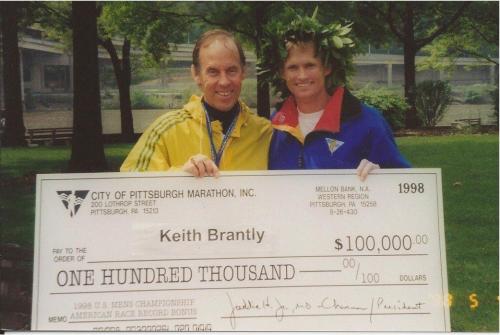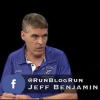 Dr. David Martin and Keith Brantly, 1998 Pittsburgh Marathon, U.S. Championships, photo courtesy of Keith Brantly
Dr. David Martin and Keith Brantly, 1998 Pittsburgh Marathon, U.S. Championships, photo courtesy of Keith Brantly
Keith Brantly was one of our sports most iconic athletes in North America. He battled hard, and long in our sport, and finished 4th twice in the 1988 and 1992 Olympic Trials marathons. He finally made the team in 1996 Olympic Trials marathon. His piece below is a thoughtful remembrance of the man who had much influence in over Brantly’s career.
Remembering Dr. David Martin through the eyes of Keith Brantly – by Jeff Benjamin
“This is a snapshot of a small part of Dr. David Martin’s life and our time together. I use the terms “snapshot” and “small part” because my time with Dr. Dave was just a moment in time for him. I’m very certain and I recognize the stories of several hundred other athletes, coaches, colleagues and friends who interacted with Dr. Dave could fill a several-thousand-page journal. I only believe my story is unique because he was my coach, and he always made me feel that, to him, I was the most important person on earth.
I first met Dr. Dave at the 1984 Olympic Track Trials during a breakfast with Pat Porter and Dave. At breakfast, Dr. Dave subtly reeled off name after name of world-class runners who at one time or another he had advised or advised their coaches. The list of last names Dr. Dave mentioned included Coe, Bickford, Gregorek, Sly, Letko, Sinclair, Durden, Pinocco, Sandoval, just to name a few. Most interestingly, Dave never insinuated these athletes ran well because of him. It was just a matter of fact that they sought him out.
I was re-introduced to Dr. Dave in November of 1984 at the NYC Marathon by Tom Raynor, eventual CEO and President of Fleet Feet. During our re-introduction and being the ever-so-cocky athlete that I was, I “told” Dr. Dave that I wanted him to coach me. He promptly “told” me that he didn’t coach anyone, but he would bring me to his lab in Atlanta in early 1985 for a series of “tests” funded by the USOC Elite Athlete project. The goal of the testing would be to gather physiological data, applying the results to improve training and track the data over a number of years. Little did I know how absolutely tortuous the tests would be, but my hope was that I would convince Dr. Dave to coach me as a “long-term” experiment. I will say, Dr. Dave always rewarded my treadmill tortures and blood draws with a huge orange juice and breakfast at the Original House of Pancakes. Dr. Dave always chose the OHOP over IHOP because in his words, “quality athletes need a quality breakfast.”
As fate would have it, convincing Dr. Dave to coach me was not too difficult. After my first battery of physiological testing in early 1985, according to Dr. Dave, I had some unique physiological traits such as a high-max VO2 and “nice” ratio of fast-twitch to slow-twitch muscle-fibers (I’m sure he told every athlete that visited his lab for testing the very same things.) However, I also had a huge problem that seemed to intrigue him; I had very bad exercise and allergy-induced asthma. Growing up, my parents smoked very heavily, and I have a family history of severe challenges with asthma. Luckily for me, Dr. Dave was a Professor of Cardio-Pulmonary Care Sciences at Georgia State University and he likely viewed my asthma as a challenge rather than a handicap.
And so, from early 1985, Dr. Dave and I began a journey filled with successes, heartbreaks, laughs, tears and incredible enlightenment that changed the course of my life for the better. A journey I originally thought would only take me through my retirement from running at about age thirty or 1992. However, I quickly realized that Dr. Dave had a long-range plan; not four years or even eight years. When he began to sketch out a sixteen-year plan, I thought he was crazy; but thank goodness, he was crazy like a fox! Dr. Dave’s penchant for long-range planning was fortuitous in my case as I would need every extra minute, hour, day and year to qualify for our primary mission, the Olympics. Most coaches planned from season to season, Dr. Dave made my training plans based on quadrennials.
Dr. Dave’s long-range planning of my running career was rewarded when, after close misses in the 1988 and 1992 Olympic Trials, I finally qualified for the 1996 Olympics in the Marathon. I remember crossing the finish line at the 1996 Trials, embracing Dr. Dave and sobbing in his arms for what seemed to be hours. We were both so happy and relieved I would be running in Atlanta. Ironically, I would be racing on the very marathon course he helped to design. The twenty-four-mile mark of the Atlanta course sat beside the door to his lab at Georgia State University; the very lab where for eleven years prior we stretched the limits of my capabilities in the interest of improvement and science.
And as much as I could go on highlighting my career successes because of Dr. Dave, it’s the man behind the mission that is the real story. Dr. Dave was truly a giving person who cared deeply for athletes, coaches, colleagues, and our sport. Dave would constantly talk about other athletes, analyzing their successes or failures. And even when discussing poor races, Dave would always be up-beat in highlighting what was learned. He could go on endlessly with hundreds of anecdotes, quips and skewed humor that usually cut right to the point; my favorite being, “It’s not how much training you DO, rather, it’s how well you recover from the training you DO DO. Because, if you get injured or sick from DOing too much, you are in deep DOO DOO.” Dr. Dave says, “The Do-Do Rule covers a multitude of sins for the runner and has never been proven wrong.” I can’t begin to explain how many times I’ve said to my myself, “Dave was right on the mark when he said, “don’t do that” or “you should try this workout.” He always seemed to say the “right” thing or give the “right” advice for the time.
It was in the mid and early 1990’s when I began to notice what would turn out to be tell-tail signs of Dr. Dave’s soon to be a long battle with Parkinson’s Disease. Falls during his training runs became more common place and his signature, endearing raspy voice started to become even raspier. Dr. Dave never uttered a complaint about his condition, and I think he even relished the opportunity he could serve as a test patient for certain Parkinson’s treatments. Still, I couldn’t help but notice that Dr. Dave’s running became less and less frequent mainly because of the risk of a major fall and I believe this made him very sad.
And so, we are witnessing the end of a man’s life, but not the end of a man’s legacy. Dr. Dave has made a positive, indelible mark on my life for which I will try every day of my life to transfer to others. Dave has been like a father, brother, and mentor to me for more than half my life. I’m a better person because of him. We shared so many great moments together. He was with me at the start and end of my professional career…16 years and a friend for 33 years. During my career, he would not allow me to pay him one dime for his coaching service. His justification was “if you pay me, then you’ve put an hourly rate on my contribution to you, and we both know there’s no figure you could possibly afford that would accurately compensate me…so just run your best each time you race and that will be payment enough.”
And, once again…he was right.”
Indeed.
Author

Jeff Benjamin has written for 30 years for American Track and Field along with RunBlogRun. The Former President of the Staten Island AC & Chair of the Staten Island Running Association was the 5th man scorer for his Susan Wagner High School NYC XC City Championship team. Also a member of the College of Staten Island Sports Hall of Fame for XC, Jeff currently serves as the LDR Chairman for USATF NY. A passionate (or fanatical) follower of the Sport, some of Jeff's subjects have included Sebastian Coe, Emma Coburn, Eamonn Coghlan, Matt Centrowitz, Jim Spivey, Galen Rupp, Joe Newton, Tom Fleming, Ajee’ Wilson, Bill Rodgers, Allan Webb, Abel Kiviat, Jordan Hassay, Marty Liquori, Caster Semenya, Rod Dixon, Carl Lewis and Jim Ryun as well as Book Reviews and articles covering meets and races in the Northeast U.S.
View all posts




















